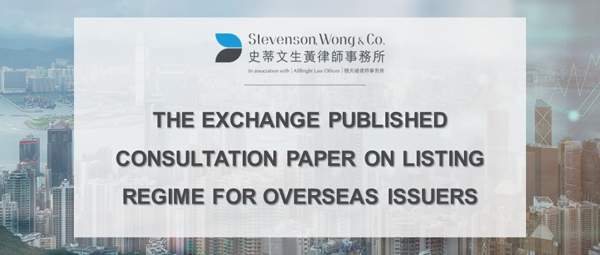On 31 March 2021, The Stock Exchange of Hong Kong Limited (the “Exchange”) published a consultation paper (the “Consultation Paper”) on a proposed streamlined listing regime for overseas issuers. According to the Exchange, this is contextual to its Strategic Plan 2019-2021 announced in February 2019, which contained an initiative to continue to develop Hong Kong as a listing and capital raising hub for major global and regional companies on either a primary or secondary basis, thereby attracting global investments seeking exposure to Asia Pacific companies and Mainland investors seeking international exposure.
The Exchange considered the current regime is affected by issues such as complexity of requirements for overseas issuers, inconsistent shareholder protection standards for recognised jurisdictions and acceptable jurisdictions, co-existence of two secondary listing regimes and more restrictive secondary listing requirements for issuers with a centre of gravity in Greater China. In view of these and other issues set out in the Consultation paper, the Exchange set out its proposals, for comment, on amendments to the Listing Rules to streamline the existing regime for overseas issuers (including those with a centre of gravity in Greater China), and also make consequential amendments to the requirements for all issuers (including Hong Kong issuers and PRC issuers).

Summary of proposals
The proposals of the Exchange are at the following dimensions. Comparison is made with the existing regime for illustrative purpose. Capitalised terms shall have the same meaning as defined in the Consultation Paper.
|
Existing Regime |
Proposed Regime |
| 1. Recognised Jurisdictions and Acceptable Jurisdictions | |
|
a. Three “Recognised Jurisdictions” – Bermuda, the Cayman Islands and the PRC b. 28 “Acceptable Jurisdictions”, i.e. jurisdictions (other than Hong Kong, the Cayman Islands, Bermuda and the PRC) that the Exchange has accepted as an issuer’s place of incorporation eligible for listing in Hong Kong |
a. No more distinction between Recognised Jurisdictions and Acceptable Jurisdictions |
| 2. Shareholder protection standards | |
|
a. All issuers must comply with Appendix 3 to the Listing Rules b. Overseas Issuers incorporated in Recognised Jurisdictions must comply with the applicable part of Appendix 13 to the Listing Rules c. Overseas Issuers incorporated in Acceptable Jurisdictions must demonstrate they can comply with the Equivalence Requirement (i.e. the Listing Rules requirement that an Overseas Issuer must be incorporated or otherwise established in a jurisdiction where the standards of shareholder protection are at least equivalent to those provided in Hong Kong) by meeting the JPS Key Shareholder Protection Standards set out in the Country Guides d. However, “Grandfathered Greater China Issuers” (i.e. Greater China issuers primary listed on a Qualifying Exchange, namely, the New York Stock Exchange LLC, NASDAQ Stock Market or the Main Market of the London Stock Exchange plc (and belonging to the UK Financial Conduct Authority’s “Premium Listing” segment) on or before 15 December 2017) and Non-Greater China Issuers (i.e. issuers primary listed on a Qualifying Exchange, which are not issuers with centre of gravity in Greater China) are subject to another set of requirements in Chapter 19C |
a. The shareholder protection standards in Chapter 19C of and Appendices 3 and 13 to the Listing Rules and the JPS will be replaced by one common set of Core Standards applicable to all issuers to establish a baseline level of investor protection for all issuers regardless of their places of incorporation b.The Core Standards cover the most fundamental shareholders’ rights relating to the notice and conduct of shareholders’ meetings, approval of important matters, members’ right to requisition a meeting, remove directors, vote, speak and appoint proxies/corporate representatives, auditors, appointment of directors to fill casual vacancies and inspection of shareholders’ register, etc. which are based on standards set out in the HKCO or already required under the Listing Rules. c.The Equivalence Requirement will be repealed as a result |
| 3. Dual primary listings | |
|
a. Grandfathered Greater China Issuers with Non-compliant WVR and/ or VIE Structures cannot retain such structures while applying for dual primary listing directly, but may become dual primary listed on the Exchange with such structures if they secondary list in Hong Kong first, and subsequently there is significant demand for their shares such that the Trading Migration Requirement (i.e. the requirement under Listing Rule 19C.13 that if the majority of trading in Greater China Issuer’s listed shares migrates to the Exchange’s markets on a permanent basis, the Exchange will regard the issuer as having a dual primary listing and consequently the Automatic Waivers will no longer apply to such issuer) is triggered b. Common Waivers available to primary and dual-primary listed Overseas Issuers are set out in the JPS |
a. Grandfathered Greater China Issuers and Non-Greater China Issuers with non-compliant WVR and/ or VIE Structures may apply directly for a dual primary listing and retain the non-compliant structures, as long as they meet the eligibility and suitability requirements of Chapter 19C for Qualifying Issuers with a WVR structure b. Codification of some conditional Common Waivers for dual-primary listed issuers and the principles for granting Common Waivers |
| 4. Secondary listings | |
|
a. Two routes: the JPS (only available to Overseas Issuers that do not have a centre of gravity in Greater China) and Chapter 19C of the Listing Rules b. Common Waivers available to secondary listed Overseas Issuers are only set out in the JPS c. Automatic Waivers are (a) set out in the JPS for JPS Secondary Issuers; and (b) codified in Chapter 19C of the Listing Rules for issuers with, or seeking, a secondary listing under that chapter d. Greater China Issuers with or without a WVR structure must (i) demonstrate that they are “Innovative Companies”; and (ii) have a minimum market capitalisation at listing of HK$40 billion (or HK$10 billion with revenue of HK$1 billion in the most recent audited financial year) e. Only Greater China Issuers are subject to the Trading Migration Requirement f. JPS Automatic Waivers eligibility requirements: (i) Listing on a Recognised Stock Exchange (as set out in JPS); (ii) Five years’ good compliance record; (iii) Market capitalisation of US$400 million (approximately HK$3.1 billion) or more g. Listing Rules are silent on the application of Automatic Waivers for a secondary listed issuer that de-lists from the stock exchange on which it is primary listed h. Listing Rules are silent on whether a Grandfathered Greater China Issuer or a Non-Greater China Issuer can retain its Non-compliant WVR and/ or VIE Structures if it delists from the overseas exchange on which it was primary listed |
a. Codification and consolidation of requirements of the two routes to secondary listing b. Codification of all secondary listing related JPS provisions (including Common Waivers and Automatic Waivers for JPS Secondary Issuers) into Chapter 19C of the Listing Rules c. Non-WVR Greater China Issuers seeking a secondary listing (i) are no longer required to demonstrate that they are “Innovative Companies”; and (ii) have the option of meeting a minimum market capitalisation at listing of either HK$3 billion (with a track record of good regulatory compliance of at least five full financial years on a Qualifying Exchange or on any Recognised Stock Exchange, as the case may be) or HK$10 billion (with a track record of good regulatory compliance of at least two full financial years on a Qualifying Exchange) d. All secondary listed issuers are subject to the Trading Migration Requirement e. Codification of JPS Automatic Waiver eligibility requirements with minor modifications: (a) the compliance record requirement changed from “five years” to “five full financial years”; and (b) the minimum expected market capitalisation requirement changed from US$400 million to HK$3 billion f. An issuer will be regarded as having a primary listing on the Exchange upon its de-listing from the stock exchange on which it is primary listed. The issuer shall notify the Exchange in advance of any anticipated de-listing (voluntary or involuntary) from the stock exchange on which it is primary listed and, among other things, details of any proposed waivers or continued relief/ grace period for full compliance with any Listing Rules requirements (including the bases for requesting such waivers/ relief/ grace period) g. The Exchange may, on a case-by-case basis, exercise its discretion to grant a time-relief waiver, suspend trading of the issuer’s shares or impose other measures as it considers necessary for the protection of investors and the maintenance of an orderly market. The Exchange will issue relevant guidance. h. A Grandfathered Greater China Issuer or a Non-Greater China Issuer is allowed to retain its Non-compliant WVR and/ or VIE Structures (subsisting at the time of its secondary listing in Hong Kong) if it de-lists from the Qualifying Exchange on which it is primary listed |

Analysis and Takeaways
The Consultation Paper represents an attempt of the Exchange to unify the existing regimes relating to the application for dual primary and secondary listings of overseas issuers. As the Exchange observed, the market feedback was that the rules are “fragmented, complex and difficult to navigate”, and as a result, the complexity of these requirements may not be conducive to compliance.
The proposed changes are expected to enhance comprehensibility of the rules and the regulatory regime as a whole, resulting in higher regulatory certainty. It is expected that this may create incentives for overseas issuers which are already primary listed in other exchanges, to explore possibilities of applying for dual primary listing or secondary listing on the Exchange.
It should also be noted that the proposed changes have removed certain more restrictive requirements for issuers with a centre of gravity in Greater China. This may well encourage and facilitate further “homecoming” secondary listing attempts of these issuers.
Please contact our Partner Mr. Rodney Teoh for any enquiries or further information.
This newsletter is for information purposes only. Its content does not constitute legal advice and should not be treated as such. Stevenson, Wong & Co. will not be liable to you in respect of any special, indirect or consequential loss or damage arising from or in connection with any decision made, action or inaction taken in reliance on the information set out herein.
